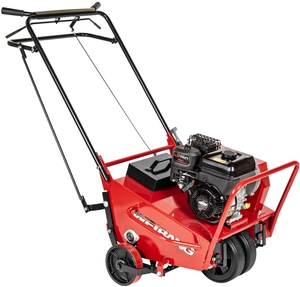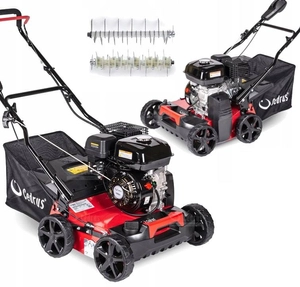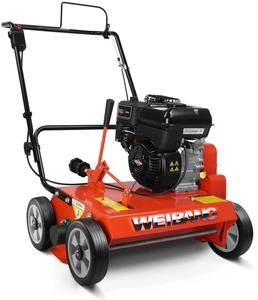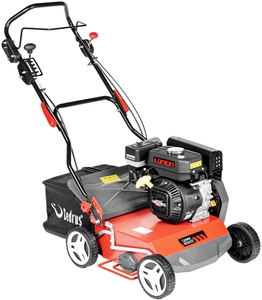SCARIFIERS AND AERATORS - WHAT ARE THEY USED FOR AND WHAT IS THE DIFFERENCE BETWEEN THEM?

You take care of your lawn by only watering and mowing it? It may not be enough. As with plants or growing vegetables, grass also needs proper care, especially in the spring. Caring for your lawn so that it pleases your eye requires the right measures. These include scarifying and aerating.
What is scarification?
It's a maintenance procedure that involves vertically cutting the turf, or dense grass cover. Scarification has several purposes, these include m.in.: providing the soil with better access to air, water, minerals, and light, and removing pests, dead plants, leaves, or sticks. Special tools are used for this purpose, namely scarifiers. They cut the roots of grasses, stimulating new shoots to grow. As you can easily guess - thanks to such treatment, the lawn becomes dense and healthy, plus it looks beautiful and invites recreation.
It is worth taking a closer look at scarifiers. As standard, they are equipped with special knives whose task is to mechanically remove unwanted plant debris or mosses from the surface of the grass. The main tasks of the scarifier include:
- combing out old grasses,
- removal of dried rhizomes,
- uncovering young shoots of growing grass,
- trimming dried blades of grass,
- incision and removal of felt,
- moss removal.
What is aeration?
Time to clarify another term. Aeration, as it is referred to, is a procedure involving deep puncturing of turf with special spikes or tubular knives. The resulting punctures extend to ca. 10 cm deep into the ground, which changes the soil structure.
Aeration is divided into two types:
- surface aeration,
- deep aeration.
The first type is characterized by a shallow incision of the soil, at about 3-4 cm. Surface aeration is usually performed on young, moss-free lawns where the grass is in good condition.
The second type, or deep aeration, involves creating holes 8-10 cm deep in the soil. This action is used on more neglected areas, moss infested, old lawns and where the grass is in poor condition.
Exploitation of the garden makes its surface thicken by trampling, kneading and melting snow. This leads to the hardening of the soil, and this - to block or reduce the supply of air, water and fertilizer. A so-called "felt" made of organic matter is formed, which can lead to withering and yellowing of grasses. Aeration loosens the soil, makes it soft, which in turn allows grass roots to grow better. This action improves plant growth conditions and also makes the lawn more flexible.
Other lawn aeration tasks are:
- oxygenation of the earth,
- grass root reinforcement,
- removal of moss and weeds,
- improving water flow,
- increasing resistance to trampling,
- accelerate lawn regeneration.
What is the difference between a scarifier and an aerator?
Because of the effects of the work, many people may conclude that there is no difference between a scarifier and an aerator. Nothing could be further from the truth! Of course, scarifying can serve to shallowly aerate the soil, nevertheless, it also serves to comb out old grasses, remove moss and felt. An aerator, on the other hand, is a device that primarily serves to aerate the soil by puncturing it, rather than cutting it.
Scarification is a process that interferes with the soil. It should be conducted once, top twice a year. In smaller gardens, one scarification per year is definitely enough. Aeration is usually carried out on a larger, more exploited area. It can be carried out more often (usually twice a year), as it does not interfere so much with the soil, and at the same time can effectively raise the aesthetic level of the lawn.
The difference between how to use a scarifier and how to use an aerator also applies to the preparation of the ground itself. With an aerator, the lawn should be trimmed to three centimeters, then the cut grass should be raked and collected, and the lawn watered. The aeration process can be started only after the grass has dried out. With a scarifier, the grass should be cut to a much smaller height.
For aeration, it is best to choose warm months, i.e. July and September. Scarifying, on the other hand, should be done in early spring (but when temperatures are already above 0 deg C). C and it is certain that they will not fall below this value). The scarification process can be repeated in autumn if necessary, but most often it is not required, especially if you take care of your lawn regularly.
The difference between aeration and scarification | ||
Factor | Aeration | Scarification |
How many times to perform? | 2 times a year | 1-2 times a year |
When to perform? | July and September | Early spring (e.g., April) |
Grass height | Grass trimmed to 3 cm | Grass cut very low |
Tasks of treatments | Soil aeration; increase accessibility to air, water and fertilizers | Aerate soil; remove felt; remove moss; harvest old grass; expose young shoots; increase soil availability to air, water and fertilizer |
Which machine to choose?
In home gardens it is recommended to scarify once a year. Aeration is mainly used for lawns in parks or other public areas that are heavily used. When it comes to a home garden, you only need a scarifier to work in it. However, if you are a professional gardener who takes care of lawns as a service, you can equip yourself with both machines, namely a scarifier and an aerator. So which machine to choose?
At CEDRUS, we provide machines to suit every gardener's needs. For those advanced, in need of a professional machine, we recommend the Weibang WB486CRB Scarifier with Briggs & Stratton 750 engine. The scarifier has many advantages, which include:
- high efficiency (power of 5 hp, designed for work on an area of 3000 m2),
- engine capacity 163 cm³,
- swiveling notching knives, driven by a double belt,
- adjustable working depth of up to 7 cm,
- easy control thanks to intuitively placed levers,
- durable, reliable design.
See:
If you are looking for an aerator, you should have in mind the area where you will be working. At CEDRUS we offer m.in. weibang WB517AB aerator designed mainly for professional gardeners, engaged in caring for large-scale lawns. The device's working depth reaches up to 70 mm, and the working width is 530 mm.
Weibang WB517AB has a high productivity of 2,700 m2 per 1 hour of work. This is a diesel aerator equipped with a Briggs and Stratton engine. It has tubular spikes constructed of high-grade steel.
One of the biggest advantages of the Weibang WB517AB aerator is that it has an independent clutch, allowing the motor and aeration tubes to be engaged separately. The drive is equipped with a belt and chain transmission, which allows efficient operation even on very difficult terrain.
See:
Recommended

WEIBANG WB457AB SPRINKLING TURBLE 5 HP B&S Briggs & Stratton 750 Series WB457 / WB 457 lawn aerator EWIMAX - OFFICIAL DISTRIBUTOR - AUTHORIZED WEIBANG DEALER

WEIBANG WB517AB SPRINKLING RUBBLE 5 hp B&S Briggs & Stratton 750Series WB517 lawn aerator EWIMAX - OFFICIAL DISTRIBUTOR - AUTHORIZED WEIBANG DEALER

WEIBANG WB384RB PROFI PROFESSIONAL STEADY COMPACT VERTICULATOR Briggs&Stratton WB384 WB 384 EWIMAX - OFFICIAL DISTRIBUTOR - AUTHORIZED WEIBANG DEALER

CEDRUS WR01 SPRELINER TREATER AREATOR 2-in-1 5.5 HP - EWIMAX - OFFICIAL DISTRIBUTOR - AUTHORIZED DEALER CEDRUS


